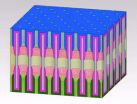(Press-News.org) AUSTIN, Texas -- Researchers at the Cockrell School of Engineering at The University of Texas at Austin have achieved a milestone in modern wireless and cellular telecommunications, creating a radically smaller, more efficient radio wave circulator that could be used in cellphones and other wireless devices, as reported in the latest issue of Nature Physics.
The new circulator has the potential to double the useful bandwidth in wireless communications by enabling full-duplex functionality, meaning devices can transmit and receive signals on the same frequency band at the same time.
The key innovation is the creation of a magnetic-free radio wave circulator.
Since the advent of wireless technology 60 years ago, magnetic-based circulators have been in principle able to provide two-way communications on the same frequency channel, but they are not widely adopted because of the large size, weight and cost associated with using magnets and magnetic materials.
Freed from a reliance on magnetic effects, the new circulator has a much smaller footprint while also using less expensive and more common materials. These cost and size efficiencies could lead to the integration of circulators within cellphones and other microelectronic systems, resulting in substantially faster downloads, fewer dropped calls and significantly clearer communications.
The team of researchers, led by Associate Professor Andrea Alu, has developed a prototype circulator that is 2 centimeters in size -- more than 75 times smaller than the wavelength of operation. The circulator may be further scaled down to as small as a few microns, according to the researchers. The design is based on materials widely used in integrated circuits such as gold, copper and silicon, making it easier to integrate in the circuit boards of modern communication devices.
"We are changing the paradigm with which isolation and two-way transmission on the same frequency channel can be achieved. We have built a circulator that does not need magnets or magnetic materials," Alu said.
The researchers' device works by mimicking the way magnetic materials break the symmetry in wave transmission between two points in space, a critical function that allows magnetic circulators to selectively route radio waves. With the new circulator, the researchers accomplish the same effect, but they replace the magnetic bias with a traveling wave spinning around the device.
Another unique feature is that the new circulator can be tuned in real time over a broad range of frequencies, a major advantage over conventional circulators.
"With this technology, we can incorporate tunable nonreciprocal components in mobile platforms," said Nicholas Estep, lead researcher and a doctoral student in the Department of Electrical and Computer Engineering. "In doing so, we may pave the way to simultaneous two-way communication in the same frequency band, which can free up chunks of bandwidth for more effective use."
For telecommunications companies, which pay for licenses to use frequencies allotted by the U.S. Federal Communications Commission, a more efficient use of the limited available bandwidth means significant cost advantages.
Additionally, because the design of the circulator is scalable and capable of circuit integration, it can potentially be placed in wireless devices.
"We envision micron-sized circulators embedded in cellphone technology. When you consider cellphone traffic during high demand events such as a football game or a concert, there are enormous implications opened by our technology, including fewer dropped calls and clearer communications," Estep said.
The circulator also could benefit other industries that currently use magnetic-based circulators. For instance, circulators used in phased arrays and radar systems for aircraft, ships and satellites can be extremely heavy and large, so minimizing the size of these systems could provide significant savings.
"We are also bringing this paradigm to other areas of science and technology," Alu said. "Our research team is working on using this concept to protect lasers and to create integrated nano-photonic circuits that route light signals instead of radio waves in preferred directions."
INFORMATION:
This research was supported by the Defense Threat Reduction Agency and the Air Force Office of Scientific Research.
The University of Texas at Austin is committed to transparency and disclosure of all potential conflicts of interest. All UT investigators involved with this research have filed their required financial disclosure forms with the university. None of the researchers have reported receiving any research funding that would create a conflict of interest or the appearance of such a conflict.
Lighter, cheaper radio wave device could transform telecommunications
2014-11-10
ELSE PRESS RELEASES FROM THIS DATE:
New electron spin secrets revealed
2014-11-10
Researchers from the Norwegian University of Science and Technology (NTNU) and the University of Cambridge in the UK have demonstrated that it is possible to directly generate an electric current in a magnetic material by rotating its magnetization.
The findings reveal a novel link between magnetism and electricity, and may have applications in electronics.
The electric current generation demonstrated by the researchers is called charge pumping. Charge pumping provides a source of very high frequency alternating electric currents, and its magnitude and external magnetic ...
Catalyst-where-you-want-it method expands the possibilities for new drug development
2014-11-10
LA JOLLA, CA--November 10, 2014--Chemists at The Scripps Research Institute (TSRI) and the Shanghai Institute of Organic Chemistry have described a method for creating and modifying organic compounds that overcomes a major limitation of previous methods. The advance opens up a large number of novel chemical structures for synthesis and evaluation, for example, as candidate pharmaceuticals.
The new method was designed to avoid an unwanted side effect--a diversion of a catalyst molecule to the wrong location--that prevents chemists from manipulating many organic compounds ...
Iron fertilization less efficient for deep-sea CO2 storage than previously thought?
2014-11-10
The Southern Ocean plays an important role in the exchange of carbon dioxide between the atmosphere and the ocean. One aspect of this is the growth of phytoplankton, which acts as a natural sponge for carbon dioxide, drawing the troublesome greenhouse gas from the atmosphere into the sea. When these plankton die they can sink to the bottom of the ocean and store some of the carbon dioxide they have absorbed, a process scientists call the "biological carbon pump".
Although many areas of the Southern Ocean are rich in nutrients, they often lack iron, which limits phytoplankton ...
Some neurons can multitask, raising questions about the importance of specialization
2014-11-10
Cold Spring Harbor, NY - Think about all the things you are doing at this moment. As your eyes scan across the lines of this article, maybe your brain is processing the smell of coffee brewing down the hall and the sound of leaf blowers outside your window. Maybe you are tapping your foot and spinning a pen between your fingers. At any given moment, your brain is simultaneously processing a multitude of information from your senses while supporting a dizzying array of behaviors.
How is all this information processed at once? The provisional answer, for decades, has centered ...
A billion holes can make a battery
2014-11-10
COLLEGE PARK, Md. -- Researchers at the University of Maryland have invented a single tiny structure that includes all the components of a battery that they say could bring about the ultimate miniaturization of energy storage components.
The structure is called a nanopore: a tiny hole in a ceramic sheet that holds electrolyte to carry the electrical charge between nanotube electrodes at either end. The existing device is a test, but the bitsy battery performs well. First author Chanyuan Liu, a graduate student in materials science & engineering, says that it can be ...
Good vibrations give electrons excitations that rock an insulator to go metallic
2014-11-10
OAK RIDGE, Tenn., Nov. 10, 2014--For more than 50 years, scientists have debated what turns particular oxide insulators, in which electrons barely move, into metals, in which electrons flow freely. Some scientists sided with Nobel Prize-winning physicist Nevill Mott in thinking direct interactions between electrons were the key. Others believed, as did physicist Rudolf Peierls, that atomic vibrations and distortions trumped all. Now, a team led by the Department of Energy's Oak Ridge National Laboratory has made an important advancement in understanding a classic transition-metal ...
Re-learning how to read a genome
2014-11-10
Cold Spring Harbor, NY - There are roughly 20,000 genes and thousands of other regulatory "elements" stored within the three billion letters of the human genome. Genes encode information that is used to create proteins, while other genomic elements help regulate the activation of genes, among other tasks. Somehow all of this coded information within our DNA needs to be read by complex molecular machinery and transcribed into messages that can be used by our cells.
Usually, reading a gene is thought to be a lot like reading a sentence. The reading machinery is guided ...
Thousands of never-before-seen human genome variations uncovered
2014-11-10
Thousands of never-before-seen genetic variants in the human genome have been uncovered using a new genome sequencing technology. These discoveries close many human genome mapping gaps that have long resisted sequencing.
The technique, called single-molecule, real-time DNA sequencing (SMRT), may now make it possible for researchers to identify potential genetic mutations behind many conditions whose genetic causes have long eluded scientists, said Evan Eichler, professor of genome sciences at the University of Washington, who led the team that conducted the study.
"We ...
Statins reverse learning disabilities caused by genetic disorder
2014-11-10
UCLA neuroscientists discovered that statins, a popular class of cholesterol drugs, reverse the learning deficits caused by a mutation linked to a common genetic cause of learning disabilities. Published in the Nov. 10 advance online edition of Nature Neuroscience, the findings were studied in mice genetically engineered to develop the disease, called Noonan syndrome.
The disorder can disrupt a child's development in many ways, often causing unusual facial features, short stature, heart defects and developmental delays. No treatment is currently available.
"Noonan ...
A greasy way to take better protein snapshots
2014-11-10
Thanks to research performed at RIKEN's SACLA x-ray free electron laser facility in Japan, the dream of analyzing the structure of large, hard-to-crystallize proteins and other bio molecules has come one step closer to reality. In the study published in Nature Methods, researchers used a newly developed grease to suspend small crystals of lysozyme, glucose isomerase, thaumatin, and fatty acid-binding protein type-3, which they then analyzed using the revolutionary serial femtosecond crystallography method.
Crystallography, which was first performed just a century ago, ...







